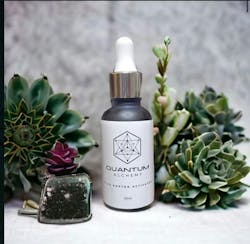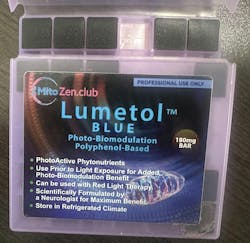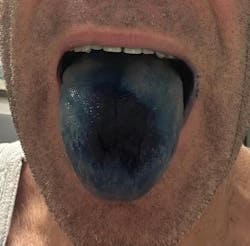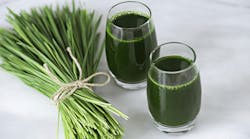What is methylene blue?
Recently, a social media post featured Robert Kennedy, Jr. drinking blue water, which was then assumed to be a result from the addition of a compound known as methylene blue. This has sparked both controversy and renewed interest in this product as an antiaging supplement as well as a mitochondrial booster. This article explores the history and offers an in-depth review of methylene blue.
What is methylene blue?
Methylene blue (methylthioninium chloride) was synthesized as a textile dye in the late 1800s, and it became the first synthetic drug to be used in humans. It was used for the treatment of malaria, and psychiatrists used methylene blue in the experimental treatment of schizophrenia.
Today, this synthetic drug is approved by the FDA for use for in the treatment of methemoglobinemia and as an effective suppressor for tau protein aggregation, a key protein in the brain that when accumulated inside neurons can lead to Alzheimer’s and Parkinson’s disease.1 Recently, methylene blue has been employed intensively for the treatment of various diseases such as septic shock,2 carbon monoxide poisoning, cyanide poisoning,3 ifosfamide neurotoxicity,4 and Alzheimer's disease.5
Nowadays, methylene blue is used as a nootropic (a brain booster) to increase memory, mood, and longevity. It boosts mitochondrial energy, increases cerebral blood flow, is antiaging, acts as an antidepressant, and is currently being used in alternative medicine for mild cognitive impairment, Alzheimer’s dementia, and Parkinson’s disease, as well as other neurodegenerative disorders. All these conditions share a common problem with mitochondrial function. Methylene blue has also been used to mitigate cancer chemotherapeutic side effects, methemoglobinemia, urinary tract infections, and cyanide and carbon monoxide poisoning.6
How does methylene blue work?
Methylene blue works by reducing the formation of free radicals and nitric oxide during hypoxic events, while it complements the mitochondrial electron transfer chain. Methylene blue’s action on mitochondrial respiration is also coupled with the biochemical upregulation of the oxygen consumption machinery in general. This upregulation remains even after the methylene blue is expelled from your system, and over time, it can increase the number of mitochondria.
Methylene blue also activates the Nrf2 pathway.7 Nrf2 is a transcription factor that, when activated, goes into the cell’s nucleus and binds to the antioxidant response element (ARE) in the DNA. It then induces the transcription of further cytoprotective enzymes such as glutathione, superoxide dismutase catalase, glutathione peroxidase, phase II enzymes, heme-1 oxygenase, and many others.
Methylene blue for mitochondria
Methylene blue can be particularly useful for addressing any condition that interferes with oxygenation or cellular respiration as it can bypass that point of interference through electron cycling, thus allowing mitochondrial respiration, oxygen consumption, and energy production to function as they normally would. Failure of mitochondrial function allows for early cell senescence (cells dying prematurely) and deleterious apoptosis (cells dying and leaving behind toxins), which in turn allows for unwelcomed and unchecked inflammation. This is detrimental to the brain, heart, and the whole body. This is where methylene blue steps in and is possibly one of the most important antiaging compounds. As a nootropic, methylene blue quickly crosses the blood-brain barrier. It improves mitochondrial efficiency and respiration, acts as an antioxidant, and increases brain cell lifespan, resulting in improved memory and mood.
Other properties of methylene blue
Memory enhancer
Methylene blue improves memory. Unlike other nootropics, which often work by increasing neurotransmitter synthesis and neural signaling, methylene blue improves memory by increasing brain cell respiration or how the brain cell utilizes oxygen.
Studies show dramatic increases in cellular oxygen consumption and glucose uptake when using methylene blue.8 It increases CMRO2 (cerebral metabolic rate of oxygen) through increased activity in the mitochondrial electron transport chain. Methylene blue also inhibits monoamine oxidase (MAO) and acetylcholinesterase activity, which increases levels of catecholamines and acetylcholine, and boosts serotonin and norepinephrine, affecting anxiety, depression, and memory.
Neuroprotectant/antioxidant
Reactive oxygen species are produced inside mitochondria. The first free radical that is formed inside a cell is superoxide. Methylene blue will bind to superoxide and reduce it to water. It stops the oxidative cascade at its very beginning before it gets a chance to do damage. Methylene blue also stimulates glucose metabolism. Increases in cerebral metabolic rate and glucose uptake mean that methylene blue elevates oxygen consumption, which helps glucose increase ATP production. Increases in ATP production provide more cellular energy for better overall brain function, including cognition, mood, and memory.
Mitochondrial energy
Methylene blue assists all cell/brain cell/myocardial cell respiration by increasing oxygen. By donating electrons to the electron transport chain within mitochondria, methylene blue functions as an alternative electron carrier in the electron transport chain in mitochondria. It accepts electrons from NADH and transfers them to cytochrome c.9 Cytochrome complex (cytochrome c) is a component of the electron transport chain in mitochondria. This same process is used to create ATP within mitochondria from the food you eat.
Antiaging supplement
Methylene blue has long been known to be a potent antiaging compound. Its ability to improve mitochondrial efficiency, reduce oxidative stress and inflammation, increase brain cell lifespan, and improve memory makes it an essential part of any biohacking regimen.10 It is worth taking the time to understand how this simple, yet powerful compound can benefit you. By taking methylene blue as part of the biohacking regimen, you can improve brain health and unlock the potential inside yourself.
How do you take methylene blue?
Methylene blue is usually found in a powdered, desiccated form that can be combined with water to create a liquid (figure 1). It also can be found in tablet form (figure 2) when compounded and pressed into solid formation.
The dosage for methylene blue ranges from 0.5–4 mg per day (low dose) up to 40–100 mg per day (high dose). Caution should be taken for people on MAO inhibitors and other SSRI drugs as excess doses can result in serotonin syndrome. After taking this medication, it is not uncommon for people to develop a blue tongue; social media calls it “smurf tongue” (figure 3).
Of extreme importance with this supplement is where you source your methylene blue from. As Johnah Bolt from Quantum Collective states, make sure you source methylene blue from a US GMP-certified lab. There are five types of methylene blue, so you have to be careful where you buy it. Quantum Collective has the highest grade—a crystalline grade that sparkles like glitter in the light. The lowest grade is used to clean fish tanks and should not be taken for human consumption. Every methylene blue tested on Amazon (about a dozen), all had heavy metals and are sourced from India and China (where there’s no regulation). Quantum Collective offers a 2% solution, which is the strongest on the market to date. They have also developed a capsule form with Aceola (vitamin C) which makes these capsules a super antioxidant powerhouse for energy and detoxification. For more information on this product, visit the Quantum Collective website. As with any supplement or medication, talk to your health-care provider prior to starting this medication.
Disclaimer: Neither author has any financial relationship or has received any monetary gain from any product mentioned in this article.
Editor’s note: This article originally appeared in Perio-Implant Advisory, a chairside resource for dentists and hygienists that focuses on periodontal- and implant-related issues. Read more articles and subscribe to the newsletter.
References
- Hosokawa M, Arai T, Masuda-Suzukake M, et al. Methylene blue reduced abnormal tau accumulation in P301L tau transgenic mice. PloS One.2012;7(12):e52389. doi:10.1371/journal.pone.0052389
- Paciullo CA, Horner DM, Hatton KW, Flynn JD. Methylene blue for the treatment of septic shock. 2010;30(7):702-715. doi:10.1592/phco.30.7.702
- Wendel WB. Methylene blue, methemoglobin, and cyanide poisoning. J Pharmacol Exp Ther.1935;54(3):283-298.
- Bhurtel S, Katila N, Neupana S, Srivastav S, Park PH, Choi DY. Methylene blue protects dopaminergic neurons against MPTP‐induced neurotoxicity by upregulating brain‐derived neurotrophic factor. Ann N Y Acad Sci.2018;1431(1):58-71. doi: 10.1111/nyas.13870
- Wiklund L, Sharma A, Patnaik R, et al. Upregulation of hemeoxygenase enzymes HO-1 and HO-2 following ischemia-reperfusion injury in connection with experimental cardiac arrest and cardiopulmonary resuscitation: neuroprotective effects of methylene blue. Prog Brain Res.2021;265:317-375. doi:10.1016/bs.pbr.2021.06.009
- Miclescu A, Sharma HS, Martijn C, Wiklund L. Methylene blue protects the cortical blood-brain barrier against ischemia/reperfusion-induced disruptions. Crit Care Med. 2010;38(11):2199-2206. doi:10.1097/CCM.0b013e3181f26b0c
- Stack C, Jainuddin S, Elipenahli C, et al. Methylene blue upregulates Nrf2/ARE genes and prevents tau-related neurotoxicity. Hum Mol Genet.2014;23(14):3716-3732. doi:10.1093/hmg/ddu080
- Rojas JC, Bruchey AK, Gonzalez-Lima F. Neurometabolic mechanisms for memory enhancement and neuroprotection of methylene blue. Prog Neurobiol.2012;96(1):32-45. doi:10.1016/j.pneurobio.2011.10.007
- Visarius TM, Stucki JW, Lauterburg BH. Stimulation of respiration by methylene blue in rat liver mitochondria. FEBS Lett.1997;412(1):157-160. doi:10.1016/s0014-5793(97)00767-9
- Atamna H, Nguyen A, Schultz C, et al. Methylene blue delays cellular senescence and enhances key mitochondrial biochemical pathways. FASEB J.2008;22(3):703-712. doi:10.1096/fj.07-9610com
About the Author

Micaela Milano, MBA
Micaela Milano, MBA, is the owner and founder of Meraki Integrative, where she combines her extensive professional experience and passion for holistic health to deliver personalized, transformative care. Micaela holds an MBA in business, marketing, and management from Florida International University. In 2018, she founded the Meraki Initiative, dedicating herself to integrative wellness and client empowerment. A certified 200-hour yoga teacher, Reiki practitioner, and advanced holistic health coach, Micaela also holds certifications in angelic and crystal healing, bringing a deeply personal and spiritual dimension to her work. Her approach centers on addressing the root causes of health concerns, merging functional medicine with regenerative esthetics to support both inner vitality and outer radiance.

Scott Froum, DDS
Editorial Director
Scott Froum, DDS, a graduate of the State University of New York, Stony Brook School of Dental Medicine, is a periodontist in private practice at 1110 2nd Avenue, Suite 305, New York City, New York. He is the editorial director of Perio-Implant Advisory and serves on the editorial advisory board of Dental Economics. Dr. Froum, a diplomate of both the American Academy of Periodontology and the American Academy of Osseointegration, is a volunteer professor in the postgraduate periodontal program at SUNY Stony Brook School of Dental Medicine. He is a PhD candidate in the field of functional and integrative nutrition. Contact him through his website at drscottfroum.com or (212) 751-8530.




